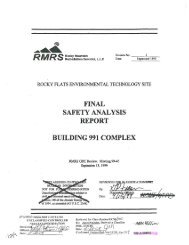silo 3 - U.S. Department of Energy
silo 3 - U.S. Department of Energy
silo 3 - U.S. Department of Energy
You also want an ePaper? Increase the reach of your titles
YUMPU automatically turns print PDFs into web optimized ePapers that Google loves.
OBS<br />
Process Control Plan for the Silo 3 Project<br />
Document No. 40430-PL-0003, Rev. 1<br />
Jacobs Project Number 35H19605<br />
September 5, 2003<br />
50 69 . I<br />
0 5.3 CONTAINER MANAGEMENT AND SAMPLING SYSTEM CONTROL PHILOSOPHY<br />
The Container Management and Packaging System is a vendor-supplied package. After<br />
final design, the vendor will provide a final detailed control system configuration and a<br />
detailed sequence <strong>of</strong> operation.<br />
@<br />
e<br />
The system is a continuously manned operation. The operators perform several manual<br />
steps to prepare the bags for filling. These steps include placing the Packaging Frame onto<br />
the Package Loading Stand, placing the container in the frame, positioning the loading<br />
spout, and coupling the container to the spout. The operator then activates the aeration<br />
blower, pre-inflating the container to conform to the frame.<br />
Operator interface is based primarily on local operation with input via local push buttons<br />
and hand switches. A primary hand control station is provided at the Package Loading<br />
Stand, and other control stations are provided as required for operation for the<br />
downstream conveyors. These control stations are suitably configured for manipulation by<br />
the operators, who are in standing positions alongside the conveyors.<br />
Control <strong>of</strong> the actual filling <strong>of</strong> the bags is a combination <strong>of</strong> manual, semi-automatic, and<br />
fully automated operations. Coupling the bag to the filling port, inflating the inner liner, and<br />
confirming an adequate closure are semi-automatic operations. Dispensing the material<br />
into the bag and operating the vibrating densification device are automated to reduce the<br />
possibility <strong>of</strong> overfilling. The operator initiates a filling sequence after having positioned the<br />
bag and having confirmed proper seal to the spout. The material discharge valve opens,<br />
and material begins to fill the container'', The vent valve opens to allow the deaeration<br />
blower to remove air from the bag as it is being filled. The densification'vibrator is<br />
activated when a fill weight <strong>of</strong> approximately 20 percent <strong>of</strong> anticipated final weight has<br />
been reached. Operators are required to visually monitor the filling level and be prepared<br />
to halt the filling process .as required; bullet cameras are provided in both fill heads to<br />
facilitate this. If overfilling occurs, a manually operated vacuum line is provided to allow<br />
operators to remove material from the bag and transfer it to the PRS.<br />
After the container is filled, the operator raises the loading spout, adjusts the inner-liner<br />
seal, and heat-seals the liner using the RF sealerle. The inner liner is then detached from<br />
the loading spout, and the gross weight <strong>of</strong> the entire assembly is measured and recorded.<br />
Using local hand controls, the operator moves the Packaging Frame from the Package<br />
Loading Stand to the Packaging Staging Conveyor, where swipe sampling is performed.<br />
The frame is then transferred to the Airlock Conveyor, and finally to the Off-Loading<br />
Conveyor. Position switches and interlocks on the conveyors and doors ensure that:<br />
'' Mixed additive solution is sprayed into the Discharge Chute Assemblies during the entire filling<br />
cycle. Once the container is full, the chute assembly's nozzles are flushed with process water,<br />
which also enters the container. See Section 8.0 for further .details on the Additive System.<br />
''The RF sealer provides a double seat at the top <strong>of</strong> the inner liner, with in-between perforation that<br />
enables the operator to tear. away the inner liner rather than cut it.<br />
5-3<br />
I<br />
I
















